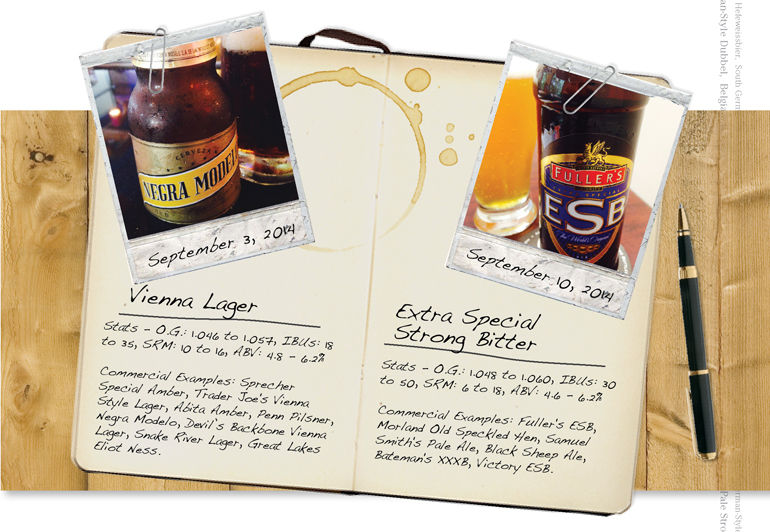Start 14-Day Trial Subscription
*No credit card required

Vienna Lager and Extra Special Strong Bitter / ESB
Extra Special Strong Bitter
A beer lover from America lands in London and walks into a recommended cask ale pub where he heads directly to the bar to eye the colorful pump clips. His mouth begins to water as he spies Fuller’s ESB. After ordering a pint, he asks the patron standing next to him if he has ever tried the ESB. “That’s a really tasty beer,” the patron replies. “But it’s very strong and goes right to my head.”
It’s really a matter of perspective. Brewed at 5.5 percent ABV in cask and 5.9 percent ABV in bottle, Fuller’s ESB would hardly seem like a strong beer to some American craft beer lovers these days, but ale drinkers in the UK are more accustomed to quaffing English bitter that’s lighter in alcohol. Ales that come in at 3.2 to 3.8 percent ABV are commonly known as “standard” or “ordinary” bitter. “Special,” or “best” bitter, falls into the 3.8 to 4.6 percent ABV span, while 4.6 to slightly over six percent versions are termed “extra special” or “strong” bitter. Often, an English brewery’s three classes of bitter are basically the same recipe -- with the strong bitter coming from the concentrated first runnings of the wort, and the best and ordinary bitter fermented from the later, weaker liquid -- after rinsing of the mash grains with hot water begins. The three beers can then be made more distinctive with additions of different hops in the boil and dry-hop stages.
Most of the hops in a true English ESB are U.K.-grown. The term “English bitter” causes some hop-inhibited drinkers to shy away from the style, but experienced drinkers will describe an ESB as malt-centered and not very bitter at all.
The “ESB” in the renowned Fuller’s brand stands for Extra Special Bitter, and the historic Fuller’s brewery in Chiswick holds a trademark for the term ESB in the United Kingdom. The trademark doesn’t apply to brewers in other countries, so ESB is frequently a part of names for American versions of the style.
Most of the hops in a true English ESB are all UK-grown, with the majority being added at the beginning of the boil to provide a balancing, yet not overly aggressive, bitterness. The term “English bitter” causes some hop-inhibited drinkers to shy away from the style, but experienced drinkers will describe an ESB as malt-centered and not very bitter at all.
When asked why the ESB style is so appealing to beer drinkers around the world, John Keeling, the brewing director at Fuller’s, replies, “There is a good balance between sweetness and bitterness -- between the malt and the hop character. This gives excellent drinkability for a beer of its strength. In our version, the typical fruity, orange quality of Fuller’s yeast adds interest and complexity to the balance.”
A typical English-style ESB will be bursting with aromas of fruit esters, toffee, caramel malt and medium to medium-high UK hop levels. While American hops usually offer notes of pine, grapefruit and/or pineapple, UK hops are characterized by more restrained, earthy aromas and flavors of wood tannins, resin, flowers and spice. Overt American hop notes are not appropriate in an English-style ESB, and butterscotch character from diacetyl should be absent or extremely low.
Pale Ale and Crystal malts highlight the grain bill of an ESB. A pleasing caramel sweetness and biscuity malt layer usually accompany a moderate to moderately high hop flavor and bitterness that linger on the finish – but do not dominate the malt complexity or medium-light to medium-full body. Some modern, golden versions of ESB are brewed exclusively with pale malt and lack caramel character.
When holding an ESB to the light, expect a bright ale with a golden to deep mahogany shade. Cask-conditioned versions in the pub usually have a low level of carbonation with a slight head, while bottled varieties are livelier.
Appropriate food pairings to complement an ESB include almost any dish with a caramelized character. Think of seared meats, grilled salmon, liver with onions, fish and chips, bacon burgers, meat pies, French onion soup and crème brûlée. The malt character of the beer melds beautifully with the browned sweetness of the caramelized food, and the bite of the beer’s bittering hops makes for a delightful contrast that resets the palate for the next mouthful of food.
Statistics
O.G.: 1.048 to 1.060
IBUs: 30 to 50
SRM: 6 to 18
ABV: 4.6 - 6.2%
Commercial Examples: Fuller's ESB, Morland Old Speckled Hen, Samuel Smith's Pale Ale, Black Sheep Ale, Bateman's XXXB, Victory ESB.



